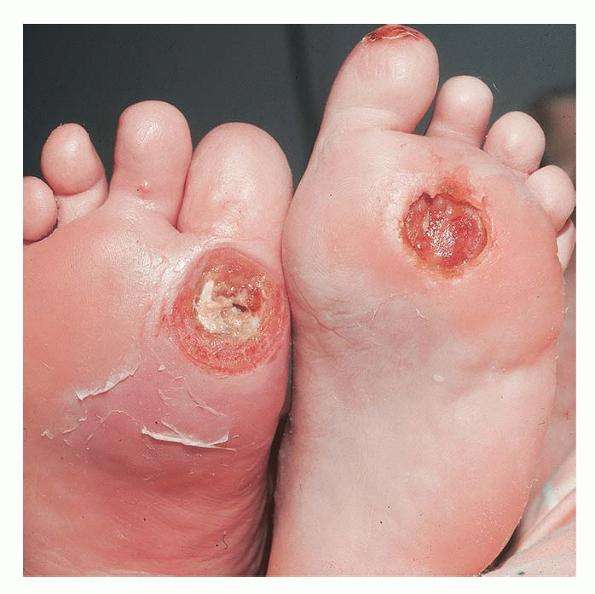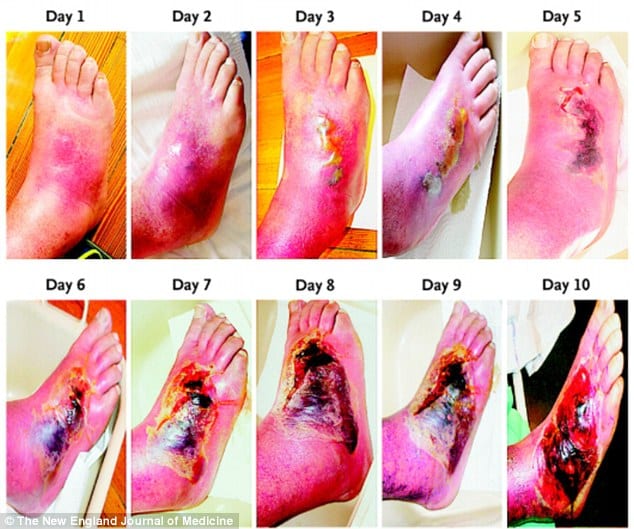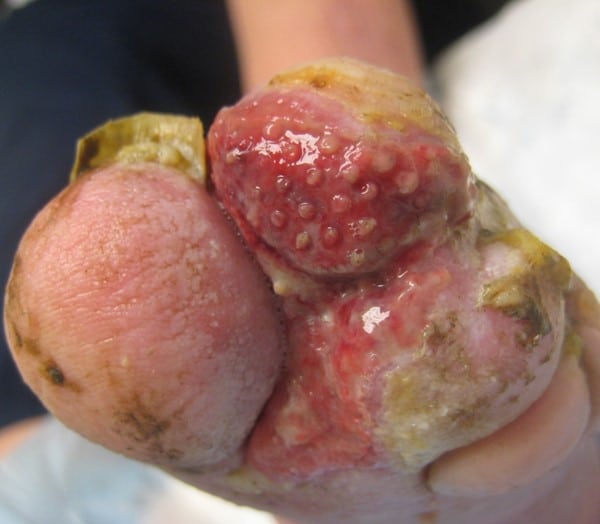How To Spot Diabetic Foot Complications Early
Foot infections are among the most common health complications in people with diabetes. When a seemingly normal wound is left untreated, it can become severely infected.
We look at the reasons why diabetics should take special care of their feet.
Why diabetics are prone to foot conditions
Diabetics have abnormally high levels of glucose in their blood for long periods of time. This can lead to artery and nerve damage, which can compromise sensation in the feet.
When diabetics get a simple cut, scrape or foot ailment and they leave it untreated, it can lead to serious complications.
The two major conditions that can ultimately cause foot problems in diabetes are:
- Neuropathy occurs because of nerve damage, causing diminished sensation in the feet. This can lead to injuries such as wounds or scrapes getting infected.
- Peripheral vascular disease a condition that affects blood flow, making it more difficult for a cut or wound to heal.
Its not that these two conditions will cause ulcers as such, but they can result in extremely poor healing of any skin injuries. Often diabetics will have an injury, such as a blister or a cut, and because they have no feeling in that region, they do not realise that they have been hurt, and continue walking on an injured foot or leg, says podiatrist Chris Delpierre.
The risk of foot ulcers and amputation
This research also states that the risk of amputation is 15 to 46 times higher in diabetics than in people who do not have diabetes.
Tips To Prevent Ulcers
Thereâs a lot you can do to lower your chance of having ulcers in the first place:
Keep your blood sugar in check. Good blood sugar control is the single best way to prevent small cuts and sores from becoming ulcers. If you have trouble managing your blood sugar, tell your doctor. They can work with you to make changes to your medication and lifestyle that will keep your blood sugar from getting too high. Even if your blood sugar level is fairly steady, itâs still important to see your doctor regularly. Thatâs especially key if you have neuropathy, because you may not feel damage to your skin and tissue.
Check your skin every day, and pay special attention to your feet. Look for blisters, cuts, cracks, sores, redness, white spots or areas, thick , discoloration, or other changes. Donât rely on pain even feeling more warmth or cold than usual can be a sign that you have an open wound on your skin, and itâs possible that you may feel nothing at all.
Ulcers are most likely to form on the ball of your foot or the bottom of your big toe, so be sure to check your feet every night. If you notice a problem, or you arenât sure if somethingâs normal, call your doctor.
Donât smoke.Smoking damages your blood vessels, decreases blood flow, and slows healing. Those things raise your risk of ulcers and amputation.
Show Sources
Controlling Pressure In The Leg Veins
Controlling swelling is essential for patients with venous leg ulcers. Leg elevation, with the feet at or above the level of the heart, several times throughout the day and while sleeping, can help reduce swelling. Compression wraps or bandages are often applied to the legs. These can be changed as often as multiple times a day or as infrequently as once a week, depending on the amount of fluid draining from the ulcer. Once the leg ulcer is smaller or nearly healed, elastic compression stockings may be recommended. Compression stockings are sized to fit the legs and are typically put on in the morning and worn throughout the day. A venous pump may be prescribed for patients with severe swelling.
Recommended Reading: Do Tums Help Ulcerative Colitis
Also Check: Can You Take Imodium If You Have Ulcerative Colitis
Tell Us About The Skin
Our research, for the first time, uncovered a skin-to-brain signaling pathway. It showed that the wound itself could cause subsequent central nervous system and behavioral changes.
We, and others, have observed behavioral and cognitive changes in our patients who have chronic wounds. It is unknown if the wound causes these changes, or they are just associated findings. The idea we proposed is that when a patient gets a wound that heals right away, there is not much sustained signaling of stress to the brain. But a chronic wound keeps activating the sensory receptors for painful stimuli , sending a more continuous skin-to-brain relay. This continuous flare generates brain signals of stress that are translated into behavioral changes.
We carried out research in mice and found that skin wounds result in a relay to the brain. This relay leads to the activation of stress markers, alteration of inflammatory mediators and changes in behavior and cognition. Mice with wounds showed more signs of despair and impaired memory than those with no wounds.
We often see similar behavior in patients with chronic wounds that need daily wound care. Some seem unable to attend to their wounds despite the serious risk of losing their foot to amputation. We also observe depression and cognitive disability reflected in the perception of inability to take care of their wounds. Some even seem to be disassociated from the reality of the serious nature of this problem.
When You Need More Treatment

If your wound doesnât heal in about a month or becomes an infection that spreads to the bone, you may need other treatments. These can include surgery and hyperbolic oxygen therapy, which involves breathing pure oxygen in a special room in order to help your body heal.
If your ulcer develops gangrene and your tissue dies, your doctor may have to amputate that area of your body.
Read Also: How To Heal Mouth Ulcers
What To Do If You Notice A Problem
The signs of diabetic ulcers on the foot should never be left untreated. If you have any of the symptoms mentioned above or think you might have a foot sore or ulcer, you should be seen by a doctor as soon as possible to avoid further damage and possible infection. The earlier you seek medical help, the less chance of complications further down the line.
Here at the Midwest Institute for Non-Surgical Treatment , we have qualified podiatrists who can provide you with the right treatment for your diabetic foot ulcer. Well also advise you on how best to look after your feet to prevent reoccurrences.
Book an appointment with Dr. Akinwande and the team who can treat you at one of our convenient locations in the St Louis area. Call us today, and well get you back on your feet and the path to recovery.
Recommended Reading: Stage 2 Pressure Ulcer Characteristics
Yellowish Scaly Patches On And Around Your Eyelids
These develop when you have high fat levels in your blood. It can also be a sign that your diabetes is poorly controlled.The medical name for this condition is xanthelasma.
Take action
- Tell your doctor about the yellowish scaly patches around your eyes.
- Talk with your doctor about how to better control your diabetes. Controlling diabetes can clear the scaly patches.
Recommended Reading: Ulcerative Colitis And Lower Back Pain
What Type Of Treatment Is Given For Leg Ulcers
The type of treatment that you are given will depend upon the severity of the ulcer. If the ulcer hasnt completely formed and a sore hasnt broken out, you may only need to use compression stockings and keep the leg elevated. This will help reduce swelling and prevent the ulcer from forming.
If an open sore has developed on the lower leg, the treatment that is recommended will be more intense. Treatment for severe ulcers includes antibiotics to fight infections, surgery to clean the wound, and dressing to protect the wound. If it is determined the ulcer is caused by venous insufficiency, your doctor may recommend you seek treatment from a vein specialist to treat the problem.
Schedule an appointment at Vein911 to discuss treatment options for leg ulcers and vein insufficiency.
What Are My Treatment Options
Treatment will depend on many factors, including the reason for the condition and your health status and history. Other factors your doctor will consider are:
- Your specific symptoms.
- How severe your condition is.
- How well you can tolerate medications or procedures.
The most common treatment for venous insufficiency is prescription-wear compression stockings, she says. These special elastic stockings apply pressure at the ankle and lower leg. They help improve blood flow and can reduce leg swelling.
You also can improve blood flow by keeping your legs elevated whenever possible, which means keeping them uncrossed when you are seated and by exercising regularly.
If you need medication, the most commonly prescribed include:
- Diuretics. These medications draw extra fluid from your body through your kidneys.
- Anticoagulants. These medications thin the blood.
- Pentoxifylline . This medication helps improve blood flow.
Recommended Reading: Best Dog Food For Dogs With Stomach Ulcers
What To Look For
Han says patients should be aware of gradual changes in sensations in the foot, such as tingling, burning and the feeling of pins and needles. This is known as neuropathy, which is diagnosed by visiting a specialist. Neuropathy can eventually lead to a loss of sensation, which makes the person more likely to experience repetitive foot trauma. This trauma can lead to foot injuries and ulcers that may become infected. Diabetes patients with hammertoes and bunions need to pay particular attention to shoes, as improperly fitted shoes can lead to corns and calluses that can become infected wounds.
A specialist will also be able to identify gradual loss of blood circulation to the lower extremities. This is caused by vascular damage in the lower legs due to high circulating blood sugar, leading to a buildup of plaque in major lower leg arteries and reduced blood flow. It is therefore imperative that patients with diabetes maintain stable blood sugar levels to prevent this vascular damage, and to visit a podiatrist regularly.
In most cases, through vigilance and working with a podiatrist, diabetes patients can avoid these complications. Data has shown that keeping blood sugar at normal levels reduces the risk of diabetic complications, including foot complications, by 50%. His mission, Han says, is to teach people how to recognize any subtle signs to get timely intervention so that foot infection and wounds can be prevented. My motto is, Educate, dont amputate!
What Happens If Leg Ulcers Won’t Heal
What separates venous leg ulcers apart from other diseases is the heightened risk of infection you have through an open sore. âIf you have a wound that hasn’t healed in two to three weeks, see your doctor or nurse practitioner right away,â she says. âThey’ll evaluate you and get you a referral to a wound care center.â
Recommended Reading: Do Enemas Help Ulcerative Colitis
Darker Area Of Skin That Feels Like Velvet
A dark patch of velvety skin on the back of your neck, armpit, groin, or elsewhere could mean that you have too much insulin in your blood. This is often a sign of prediabetes.The medical name for this skin condition is acanthosis nigricans.
Acanthosis Nigricans
Often causing darker skin in the creases of the neck, AN may be the first sign that someone has diabetes.
Take action
- Get tested for diabetes
Venous Ulcer Diagnosis And Treatment

Doctors at Vascular surgeons at UPMCs Heart and Vascular Institute use duplex ultrasound, a noninvasive test, to diagnose abnormal veins that cause venous ulcers. Part of the UPMC difference is that we actively look for the causes of the ulceration to treat venous pathology and keep the ulcer healed.
After an evaluation of your veins, we recommend a treatment plan based on your needs:
- Compression of the leg is vital to healing venous wounds.
- Compression stockings are most commonly used for this treatment.
- The pressure from the compression dressing counteracts the pressure from the veins of the leg and allows skin to heal.
Also Check: What Causes Diabetic Foot Ulcers
Diabetes: 12 Warning Signs That Appear On Your Skin
Diabetes can affect many parts of your body, including your skin. When diabetes affects the skin, its often a sign that your blood sugar levels are too high. This could mean that:
-
You have undiagnosed diabetes, or pre-diabetes
-
Your treatment for diabetes needs to be adjusted
If you notice any of the following warning signs on your skin, its time to talk with your doctor.
How Does Diabetes Increase The Risk Of Leg Ulcers
Neurotrophic ulcers, from nerve damage, affect diabetics who have high blood sugar levels.
These ulcers form most often at pressure points on the bottom of the feet. The ulcer may be discolored, pink, red, brown, or black, and is an open wound. The surrounding skin is often discolored and calloused.
Nerve damage to the legs or feet can cause symptoms such as a loss of feeling, changes to sweat glands, tingling, a burning or stinging feeling, and pain. These are predictive signs of a potential ulcer. Anyone with these symptoms should talk with a doctor and get checked.
People with diabetes should check their legs and feet frequently. Make sure there are no calluses, scrapes, or cuts. Wear good, closed footwear, never walk barefoot, and keep your legs and feet clean.
You May Like: Heel Protectors For Pressure Ulcers
Treatment For Diabetic Ulcers
When someone identifies an ulcer, they should seek medical care to prevent its progression. The primary goal of treatment is to promote healing as soon as possible. Treatment will often depend on the grade of the ulcer.
If an infection is present, a doctor will likely prescribe antibiotics. They may require a tissue sample to identify the cause of the infection. The antibiotic type and dosage a doctor suggests will depend on the infection organism and the severity of the infection.
In some cases, surgical options may be necessary to help encourage healing, relieve pressure on the area, and prevent further complications. These options may include:
- education on foot care and control of blood sugar levels
- medications for blood sugar control
- offloading pressure from the ulcer by using crutches, a wheelchair, or a non-removable cast to promote healing
- medicines to help improve blood circulation
- topical medications and dressings
What Type Of Ulcer Is A Diabetic Ulcer
What Is a Diabetic Foot Ulcer? A diabetic foot ulcer is an open sore or wound that occurs in approximately 15 percent of patients with diabetes, and is commonly located on the bottom of the foot. Of those who develop a foot ulcer, six percent will be hospitalized due to infection or other ulcer-related complication.
Don’t Miss: How Do You Get Ulcers In Your Colon
What Does The Start Of A Diabetic Foot Ulcer Look Like
Ask U.S. doctors your own question and get educational, text answers â it’s anonymous and free!
Ask U.S. doctors your own question and get educational, text answers â it’s anonymous and free!
HealthTap doctors are based in the U.S., board certified, and available by text or video.
Diagnosing A Diabetic Ulcer
An accurate diagnosis of a diabetic ulcer must be given by a medical health professional. Most doctors will first provide a physical examination of the patients foot. Should further tests be required, a doctor may recommend an X-ray or an MRI scan.
An X-ray can show any changes in foot alignment through a system of imaging. An X-ray image can show loss of bone mass and hormonal imbalances that can potentially relate to the diagnosis of diabetes.
MRI scans use three-dimensional images of the bodys soft tissue. If the extent of damage needs to be assessed, an MRI scan can use magnetic radio waves to reveal possible inflammation. This test can expose any significant infections in the foot.
One of the simplest tests a physician can use to diagnose an infectious diabetic ulcer is the blood test. This test is usually done by drawing blood at a doctors office so that the results can be sent to a lab for further information.
Recommended Reading: What Are The Symptoms Of Gastric Ulcer
What Are Venous Stasis Ulcers
Commonly located on the ankle or calf, venous stasis ulcers are painful and red in color but may be covered with a yellow, fibrous tissue and an irregular border.
Drainage and discharge are possible with venous stasis ulcers. This type of ulcer is common in patients with a history of leg swelling or varicose veins.
How Can You Prevent Neuropathic Ulcers

How Can I Prevent Diabetic Foot Ulcers?
19 related questions found
Recommended Reading: Is Kombucha Good For Ulcerative Colitis